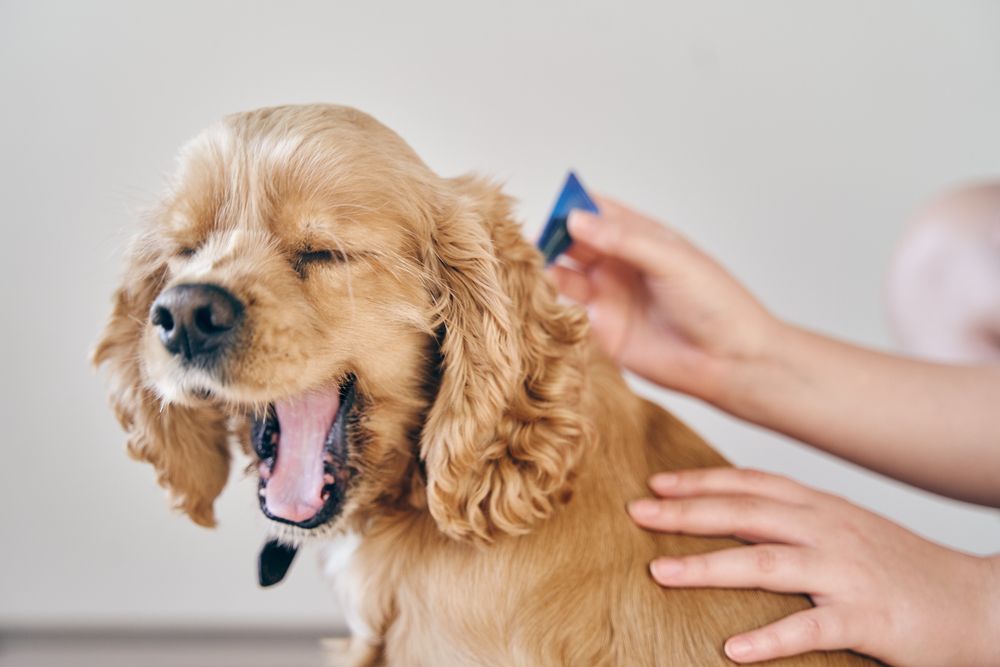Hey Ollie blog readers! We’re offering you an exclusive 60% OFF your starter box! Try now!
If you’re headed for some outdoor fun with your pup, there are quite a few things you’ll want to do to keep them safe. You’ll make sure they’re microchipped, put on a leash and a collar or harness with an up-to-date ID tag, and make sure to use some type of flea and tick preventative. If you’ve ever been curious about why the flea and tick preventative is so important, we did all the research to help you understand. For this post, we’ll focus on ticks so you can learn about where they hide, how they impact your dog, and how to best protect your pup!
What are dog ticks?
These pesky parasites may also be called wood ticks. They get their name because their preferred method of feeding is off of domesticated dogs (like your precious pet). These ticks can only be found in North America so if you’re reading this blog post from other parts of the world, this isn’t the bug you’d be looking at.
Dog ticks are a member of the hard tick family. This means they wear a hard outer shell. In addition to their desire to feed off your pup, they can also harbor bacteria that cause diseases in humans. One of the most common illnesses a human can get from a dog tick is Rocky Mountain fever.
While you’re most likely to encounter this type of tick in the summer, like with other varieties of ticks it is important to do a thorough tick check of your dog frequently. Especially after spending time in areas that are known to have ticks.
What are other types of ticks?
Dog ticks aren’t the only type of tick that can do some damage to your pup. A few other types of ticks you need to be looking for include:
Black Legged “Deer” Ticks
This tick is distinct because of its red and orange body, dark shield, and black legs. They are mostly found in the northeast and upper midwest of the united states but they have spread and can be found pretty much anywhere now.
Brown Dog Tick
The Brown Dog Tick is narrower in shape than other ticks and is reddish-brown in color. They are found worldwide but prefer to live in homes with dogs. They can spend their entire life indoors. Check dog beds and kennels for this type of tick as that is their preferred habitat.
Groundhog Tick
Light brown or blonde in color, the Groundhog Tick is also known as the Woodchuck Tick. They live in the eastern United States. They mostly feed off of groundhogs, woodchucks, skunks, and other warm-blooded mammals. This can also include humans and domestic animals like dogs.
Lonestar Tick
Another reddish-brown tick, the Lonestar Tick is recognized by the white marking on the back of the adult female tick. Mostly found in the southern US these ticks can be found along the east coast as well. They spread many diseases including STARI which is similar to Lyme disease.
Western Black-Legged Tick
These soft ticks don’t have a hard shell like the others we’ve described. They are reddish in color with a black shied and black legs. They can mostly be found in California, being established in 55 out of 58 counties. They’ve also been spotted in Oregon, Washington, Arizona, Nevada, and Utah.
Where can a dog get ticks?
Ticks can be found in many places both rugged and urban. If you are headed out into any of the following you will want to ensure that when you’re home, you check your dog carefully for ticks:
- Tall grasses
- Hiking trails
- Dog parks
- Woods
- Shrubbery
- Mountain trails
The most common place to find ticks is in tall grasses or shrubs that are around 18-24 inches off the ground. This doesn’t mean that they can’t be found lower so small pups are not immune from having a tick hitch a ride and a snack.
Where do ticks hide on dogs?
When you come in from a hike or some outdoor fun you want to check your dog thoroughly nose to tail for ticks! Some popular hiding places include in between the toes, under the collar, and under your pup’s tail. You also want to check the groin area and even your pup’s eyelids. Make sure you look at every inch of your pup so you don’t miss a tick. While this may seem a little annoying you can save yourself a lot of stress later if your up does show signs of a tick bite.
Feel free to multitask while you check. If you find any other lumps, bumps, or anything that seems off – you may have caught something early before it turned into a more serious issue! For younger pups, a tick check is a good time to get used to having their bodies touched and handled. Remember to offer lots of praise and treats while you inspect.
Do ticks make my dog sick?
In short, yes, there are several ways your pup can get sick from being bitten by a tick. They include:
Lyme disease
This is probably one of the most common and best-known tickborne illnesses. This is because humans can get it too. In dogs, symptoms might include a rash around the tick bite, some lameness, and fevers, loss of appetite, and lethargy. While you might be checking your dog for the bullseye rash that humans get when they get Lyme disease, you won’t see that on your pup according to Dr. Jerry Klein of the American Kennel Club.
Rocky Mountain Fever
Transmitted by several species of ticks including the American Dog Tick, Rocky Mountain Wood Tick, and Brown Deer Tick, this disease has been through most of the United States. Symptoms can include fever, poor appetite, swollen lymph nodes, and joint pain. Additionally, dogs with Rocky Moutain Fever can have low platelets, which help in blood clotting. Less commonly neurological signs such as wobbliness can also occur.
Canine Ehrlichiosis
This condition can be found around the world. The Brown Dog Tick, Lone Star Tick, and American Dog Tick are all carriers. Symptoms can include fever, poor appetite, and low blood platelets. The disease is often noted by nose bleeding or other signs of bruising or anemia. Signs will become apparent 1-3 weeks after the bite of an infected tick. Dogs diagnosed and treated quickly have a good prognosis, but if left untreated and the disease moves to the chronic phase, your pup may have more difficulty recovering.

How can I prevent my dog from getting ticks?
Talk to your vet about tick prevention. There are many options including topical treatments, collars, and oral medications. All of these methods come with pros and cons. Your vet will help you make the best decision for your pet based on their unique needs and health history.
Remember that even if your dog is on a tick prevention protocol you still need to check them for ticks frequently as in order for the tick to be exposed to the preventative they might need to bite the dog. The medication should kill the tick.
The Ollie blog is devoted to helping pet parents lead healthier lives with their pups. If you want to learn more about our fresh, human-grade food, check out MyOllie.com.
Tagged As:

The nutrition your dog needs,
the food they want.

Enjoying our articles? Subscribe our Newsletters and get new articles directly to your inbox
You might also like
12 August 2025
5 MINS READ
Top 8 Allergens Hiding in Your Dog’s Bowl
As pup parents, we never want to see our dogs uncomfortable. When it comes to itching, swelling, and upset stomachs, the culprit may be in their bowl. Understanding the most common allergens and t…
by Ollie Pets
11 August 2025
5 MINS READ
Not all Processing Is Equal: What’s Really in Your Pet’s Bowl?
As pet parents, we know how important it is that our dogs live long, healthy, and happy lives. This is why at Ollie, we focus so much on what goes into their bowls. But did you know there may be s…
31 July 2025
4 MINS READ
The Healthiest US States for Dogs
The Ollie Health team, a team of veterinarians and veterinary technicians, reviews thousands of photos submitted through Ollie’s Health Screening service. That’s hundreds of dogs (and their st…
by Ollie Pets







